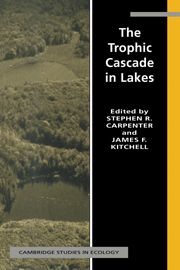Book contents
- Frontmatter
- Contents
- Contributors
- Preface
- 1 Cascading trophic interactions
- 2 Experimental lakes, manipulations and measurements
- 3 Statistical analysis of the ecosystem experiments
- 4 The fish populations
- 5 Fish behavioral and community responses to manipulation
- 6 Roles of fish predation: piscivory and planktivory
- 7 Dynamics of the phantom midge: implications for zooplankton
- 8 Zooplankton community dynamics
- 9 Effects of predators and food supply on diel vertical migration of Daphnia
- 10 Zooplankton biomass and body size
- 11 Phytoplankton community dynamics
- 12 Metalimnetic phytoplankton dynamics
- 13 Primary production and its interactions with nutrients and light transmission
- 14 Heterotrophic microbial processes
- 15 Annual fossil records of food-web manipulation
- 16 Simulation models of the trophic cascade: predictions and evaluations
- 17 Synthesis and new directions
- References
- Index
17 - Synthesis and new directions
Published online by Cambridge University Press: 06 August 2010
- Frontmatter
- Contents
- Contributors
- Preface
- 1 Cascading trophic interactions
- 2 Experimental lakes, manipulations and measurements
- 3 Statistical analysis of the ecosystem experiments
- 4 The fish populations
- 5 Fish behavioral and community responses to manipulation
- 6 Roles of fish predation: piscivory and planktivory
- 7 Dynamics of the phantom midge: implications for zooplankton
- 8 Zooplankton community dynamics
- 9 Effects of predators and food supply on diel vertical migration of Daphnia
- 10 Zooplankton biomass and body size
- 11 Phytoplankton community dynamics
- 12 Metalimnetic phytoplankton dynamics
- 13 Primary production and its interactions with nutrients and light transmission
- 14 Heterotrophic microbial processes
- 15 Annual fossil records of food-web manipulation
- 16 Simulation models of the trophic cascade: predictions and evaluations
- 17 Synthesis and new directions
- References
- Index
Summary
Introduction
Preceding chapters provide the theoretical, analytical and empirical background for food-web interactions in an ecosystem context. In this chapter, we summarize what we consider to be the major accomplishments of our work and our interpretation of certain important, unexpected results. We also provide our view of the next generation of research issues involving the interactions of food-web structure and nutrient status in lakes, and speculate about the generality of trophic cascades in terrestrial and aquatic ecosystems.
Our primary goal in designing these experiments was to evaluate the role of food-web interactions in regulating primary production rates of planktonic algae. Regressions based on data from many lakes revealed that nutrient loading rates could account for only about half of the observed variance in primary production; roughly an order of magnitude of variability among lakes remained unexplained (Carpenter & Kitchell, 1984; Carpenter et al., 1985). We reasoned that a substantial share of that was due to differences in trophic interactions and developed a set of experiments designed to test that idea. Manipulations of fish populations in Peter and Tuesday Lakes were intended to yield maximum contrast in food web structure while the reference system, Paul Lake, remained as a monitor of interannual variance due to other sources.
We found that piscivores had rapid, massive effects on planktivores (Chapters 4–6). Predator avoidance behavior exhibited by small fishes caused planktivory in the pelagic zone to decrease much more rapidly than it would have done through piscivory alone (Chapter 5).
- Type
- Chapter
- Information
- The Trophic Cascade in Lakes , pp. 332 - 350Publisher: Cambridge University PressPrint publication year: 1993
- 4
- Cited by



